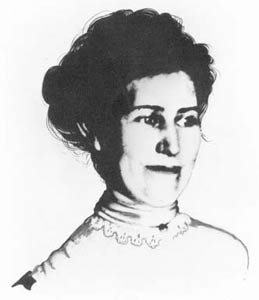Morgan Hill – In the summer of 1909, 38-year-old Isola Kennedy, a well-respected Morgan Hill woman, was attacked by a mountain lion – with tragic results.
Kennedy was engaged to local dentist Otto Puck. Living with her parents at the family home at the corner of Dunne Avenue and Church Street, the outgoing woman was well-liked and kept socially active. She frequently attended local parties and dinners, and she and her fiance joined friends on picnics and outdoor adventures such as retreats to the Llagas Creek in nearby Paradise Valley.
An active Christian, Kennedy taught Sunday school classes in a Morgan Hill church. She also sought to end the temptations of alcohol in the Bay Area by serving as the president of the Santa Clara and San Mateo Bi-County Women’s Christian Temperance Union, according to Joyce Hunter in the book “Under the Shadow of El Toro.”
“She was well respected and loved throughout the area for her good works and kindly nature,” Hunter wrote.
On July 6, 1909, as a treat Kennedy took five young boys from her Sunday school class on a picnic to Island Dell along the Coyote Creek. (The site is now under Anderson Reservoir.) The boys ranged in age from 8 to 10 years and were named Henry Merkel, Curtis Lane, Earl Wilson and brothers Emmett and Frank Fay.
Shortly after lunch, the children decided to cool off in the stream. As they splashed about in the water, a female mountain lion jumped from the creek-side bushes and slashed 8-year-old Earl Wilson with its claws, throwing him off balanced. The cat then plunged its teeth into the bleeding boy now submerged in the creek.
Hearing the screams, Kennedy picked up a stick and rushed toward the animal. She shouted at the other boys to run for help. As she went to defend Wilson, the lioness turned and attacked her, sending her to the ground.
While the attack continued, the four other boys raced to a nearby survey camp run by the Bay Cities Water Company. They told surveyor Jack Conlan, who was mapping out the area, about the lion attack. Quickly, he grabbed his shotgun and raced to the creek. A few minutes later, he arrived to see the lion on top of Kennedy as she defended herself with a long hat pin against its mauling.
Conlan later wrote: “That poor woman was struggling as best she could, armed only with her hat pin. I finally got a shot at the beast, but it paid no attention. The girl kept saying, ‘Don’t shoot me, don’t shoot me.’ I got another shot, but the lion just shook its head and intensified his savage attack.”
Conlan next tried slamming the shotgun butt into the cat’s head, but this also had no effect. Desperate at what to do next, the surveyor ran back to his camp to get his rifle and bullets. He was gone for about 15 minutes.
“To me, it seemed a very long time before I reached poor Isola,” he wrote. “To her (Kennedy), it must have seemed like years. When I returned, Isola was still conscious and struggling. I yelled for her to lie still so that I would not hit her. She did and I shot the lion behind the left shoulder. It threw up its head and I put the rifle barrel into its mouth and fired. The lion reared, then sank its teeth and all four claws into Isola and after a few struggles, died.”
Conlan and his friend Charles Fletcher pried the lion’s teeth and claws out of Kennedy’s flesh and carried her to Conlan’s cabin. Kennedy was later transported from the cabin to her parents home in a delivery wagon.
“The next day a thorough examination of her wounds was made by Dr. J. T. Higgins, assisted by Dr. F.W. Watt,” wrote Eugene Sawyer in his book “The History of Santa Clara County.”
“It was found that one ear was completely eaten off, the other ear badly lacerated, while a three-cornered cut by the right eye had laid the bone bare.”
From the wrist to her shoulder, Kennedy’s left arm had 15 deep gashes from the mountain lion’s clawing, Sawyer wrote. The woman’s right arm, leg and back were also badly lacerated.
At first, these injuries were not thought fatal. But unfortunately, the mountain lion had rabies. Kennedy and Earl were infected with hydrophobia and suffered for many weeks. In August, Earl died of lockjaw induced by blood poisoning. Isola Kennedy finally succumbed on Sept. 10, 1909.
She was buried in Mount Hope Cemetery in Morgan Hill. Her tombstone – set up by the U.S. Loyal Temperance Legionnaires – is inscribed with this simple testament:
“Sacrificed her life battling a lion to save some small boys.”








